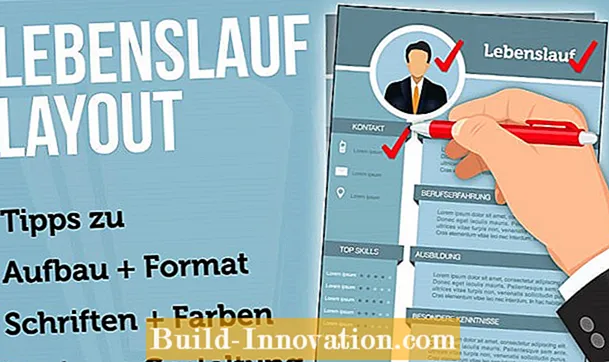Resume layout: tips for professional design

Content
- CV layout: convince in 2 minutes
- An overview of important layout rules
- Resume length
- Resume layout examples and templates
- Resume Templates: 120+ free templates
- Layout rules: fonts, spacing, formatting
- Margins
- Line spacing
- Fonts
- Font sizes
- Bold type
- Colors in the curriculum vitae
- Resume layout: tips for a modern structure
- Header
- Application photo
- Personal data
- Professional background
- Educational path
- Special Knowledge
- Interests / hobbies
- Place, date, signature
The standard for the resume layout today is the tabular resume. The respective content is sorted according to headings and divided into sections. The "antichronological" structure has prevailed within the categories. In other words: You always start with the most recent position and then go back in time. Despite a few basic rules for the resume layout, you still have numerous options for an individual design. The most important rule for the résumé is: The professional résumé must first be clear and fit to the industry and profession. In the following you will find tips, examples and templates in Word for an appealing layout that will convince HR managers ...
CV layout: convince in 2 minutes
A professional resume layout is not only reflected in an attractive look or an original design. According to studies, HR managers hardly take more than 2-5 minutes for the initial selection. The résumé is your first reading. Means: essential qualifications, knowledge and unique selling points must be able to be captured at a glance - and convince. Only then do HR managers read the rest of the application documents.
Although there are for the design of business letters (which also includes the application) DIN 5008. You can also use this as a guide for the resume layout. But more important than such specifications is a clear structure that fits your personality and the rest of the documents. This results in a professional overall impression - everything looks like it has been cast from a single source.
An overview of important layout rules
- The layout impresses with its high level of clarity.
- The structure speaks for the diligence of the applicant.
- The sections are structured consistently and coherently.
- The details mentioned are relevant to the position.
- The résumé is easy to read and meets all standards.
- It fits in harmoniously with the rest of the documents.
Resume length
A modern résumé has a length of one to a maximum of three A4 pages. Young professionals and applicants with less than 5 years of work experience should get by on one page. Experienced specialists and managers are allowed to be more detailed. However, your résumé in tabular form should not exceed three pages.
When you need to cut back, always delete information that is not relevant to the position you are aiming for. For example, educational qualifications dating back decades. Or details about positions that don't really qualify you. You don't need more than 5-6 bullet points per position anyway. And not all previous jobs have to be shown the same length in the curriculum vitae layout. Not quantity, but class increases the informative value.
Resume layout examples and templates
In the following you will find some layout examples for the tabular curriculum vitae. They all meet the above criteria and follow important aesthetic rules in design.
The free templates can also be downloaded as a Word file. Just click on the picture.
Reading tip: Create a resume in Word: complete guide + video
Resume Templates: 120+ free templates
Use our professional application designs and free application samples to apply.Benefit from more than 120 templates in the design package - including cover letter, cover sheet and résumé - all as Word files for editing.
To download the templates
Layout rules: fonts, spacing, formatting
In general, we recommend a left-aligned text alignment for all application documents - including the resume layout. The so-called "flutter sentence" looks wilder than justification, but is easier to read because the reader can jump from line to line more easily. You should also observe these formal rules when laying out your résumé.
Margins
The margins limit and influence the impact of your resume. You can set the dimensions individually in every word processing program. Make sure, however, that the text will later be in the printable area of your printer.
If you look at DIN 5008 for margins and orienting distances, there are no problems:
- Top margin: 4.5 cm (without header)
- Bottom margin: 2.5 cm (recommended)
- Left margin: 2.5 cm
- Right margin: 2 cm (but at least 1.5 cm)
Strictly speaking, the bottom margin is not fixed. But you shouldn't leave too little space below. That makes the signature look squashed later.
Line spacing
You usually choose the line spacing to be one line. You can also choose a 1.5 line spacing to stretch the content. 2 lines is too much.
Fonts
The font has probably the greatest influence on the look of your résumé. The choice of fonts in the application is huge. Classics are Arial and Times New Roman. But that's why it's anything but modern. Rather boring.
Basically, a distinction is made between two fonts:
- Serif fonts
They have little flourishes on the letters. This is for the readability of long texts. They are therefore recommended for the body text in the résumé. - Sans serif fonts
Also called "grotesque" fonts. Because they are straightforward, they are often used for headings.
Select for all documents in the application Select a maximum of two different fonts - one for running text, one for headings. You use these in all documents according to the same pattern. Instead of the classics mentioned, you have many alternatives such as Georgia or Cambria or Helvetica or Verdana (see graphic). However, all decorative fonts or supposedly funny fonts such as Comic Sans or Impact are taboo. They don't exactly stand for seriousness in the resume layout.

Font sizes
Most texts are written in a font size of 12 points. This is the standard setting in word processing programs such as Word - and they are easy to read in this font size. If you want to stand out from the crowd, follow the 11-13-15 rule:
- 11 point
This is the font size you use to write the body of the text - all longer text passages in your CV or cover letter. If possible, use a serif font. - 13 point
You only use this size for the date, sender, addresses and subheadings in the resume. Grotesque fonts (without serifs) are recommended here. - 15 point
This font size is reserved for your name in the letterhead of each page. It should stand out the most (also sans serif font).
Bold type
Bold type (colloquially "bold") are suitable for highlighting relevant content. They also make the layout clearer and give it structure. However, you should not use bold font indiscriminately, but only with a recognizable system. For example:
- Job title
Use the bold letters, for example, for your previous job titles in the positions of your professional career. The HR manager can see at a glance what you have already done. - courses
Continue the principle in the “Education” section. In this case, use bold for the name of the course, training, internship or degree. - Special Knowledge
Highlight special IT skills, experiences or successes in bold.
As with everything, the same applies here: The dose makes the poison. Bold fonts should set accents, highlight and emphasize important information. The more you overdo it, the more watered down the effect and expressiveness in the layout.
What we expressly do not recommend are underlining in the résumé. Reason: The letters “p”, “q” or “g” are crossed out at the bottom. That doesn't look particularly professional and reduces the legibility of the career.
Colors in the curriculum vitae
The most important rule for the resume colors: Use them sparingly! Especially in conservative industries. Brightly colored résumés are not well received by banks or insurance companies. The tabular curriculum vitae should not have more than ONE spot color. It should match the rest of the application layout and, if necessary, add visual color accents in the application letter and résumé.
Look professional (and modern) muted colors in the resume layout. Readers consider them reassuring and serious. A clever trick is to choose the color that matches the company - for example, to repeat its logo color. For example red for an application to the railway or blue to the police. In this way, they subtly signal a high level of identification with the job and employer.
Resume layout: tips for a modern structure
The classic structure is laid out in two columns and divided into sections and sorted according to headings. For example, the result looks like this:

To make the layout of your resume look good To personalize even further, you can also use graphics, icons or even a QR code in the respective sections. In the following you will find examples of the design of your information.
Header
The ideal CV header is "CV" or "CV first name + last name". If you add the heading to the Word header, it will appear uniformly on page 2 or 3 of the "Curriculum Vitae". This also saves space.
Application photo
According to the General Equal Treatment Act (AGG), the application photo is a voluntary addition to the curriculum vitae. However, it is still welcomed by HR professionals and can increase application chances. For some positions it is important to know what the future employee looks like (e.g. salesperson or consultant with customer contact).
The application photo must necessarily be a professional photo be from the photographer. No passport photo, no selfie! Instead of using just a single photo, you can also use four images in the resume layout that you connect to one another.

Personal data
Personal data includes (mandatory information): first name and surname, address (street, house number, zip code + city), contact details (telephone number, email, web links). As an alternative to the application photo or below it, you can also place a link or QR code in the header and personal data. This then optionally leads to an application homepage or an application video. That makes the application even more personal.

Professional background
Another component in the structure of your resume layout is your professional career, also known as "work experience". Here the employment period is usually set on the left (sample: MM / YYYY - MM / YYYY) and on the right in a second column the respective position and description. This applies to full-time jobs as well as mini-jobs or part-time jobs.
When changing jobs internally You can present this in a structured manner in your résumé - for example because of a promotion. In this case, the total period of employment and the employer are indicated first. Then follow - indented - the time periods of the individual positions.

Educational path
“Apprenticeship” not only includes vocational training, but also studies or school education. In this layout section, however, only the degree and the overall grade are usually important. The primary school is not listed if it was more than 10 years ago.

Special Knowledge
Additional qualifications prove further commitment and add value to the résumé. However, only list skills that fit the desired position and offer added value there. For example: language skills, IT skills, further training or volunteer work. If possible, describe the knowledge including an assessment. In the case of language skills, for example, the language level (basic knowledge, business fluent, ...).

Interests / hobbies
Interests and hobbies are often underestimated (alternative headings: “engagement”, “leisure activities”). They complete the applicant's profile. It is not uncommon for relevant soft skills to be hidden here.
But again only mention such hobbieswho document experiences that are useful for the job, demonstrate leadership qualities or underline social skills. Dangerous hobbies (skydiving, motocross, etc.) should be left out. Here employers fear accidental absences.
Place, date, signature
Formally, the résumé must be completed with the place, date and a personal signature. By signing, you confirm that the information provided is true. The date indicates that the CV is up to date. Ideally, you should sign with a fountain pen or ballpoint pen (no pencil, no felt-tip pens!) In blue or black.
With the online résumé you should scan your handwritten signature beforehand, cut it out and then insert it into your résumé like a picture.
If you take all these points into account one after the other in your resume layout, you will get a perfect resume that recruits immediately notice and - assuming the right qualifications - positively addresses. A real plus for your job opportunities. We wish: good luck!



